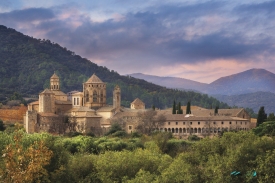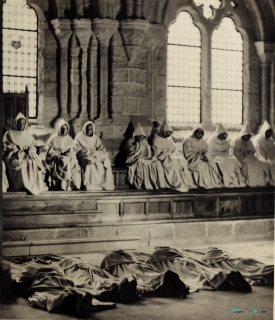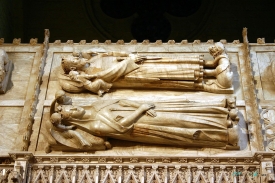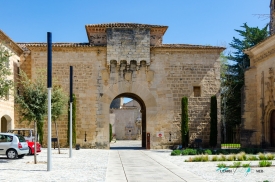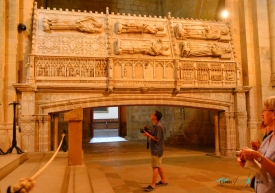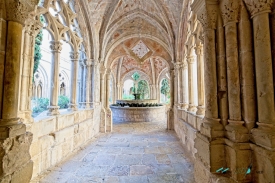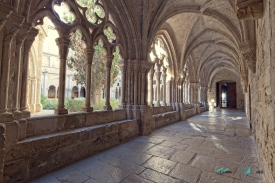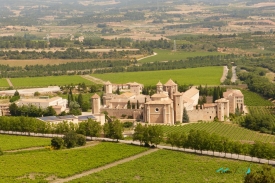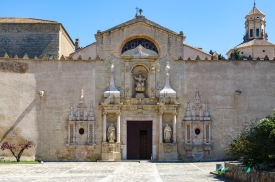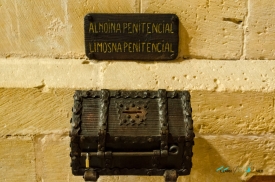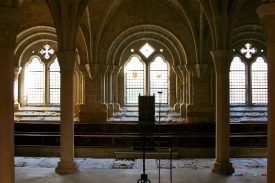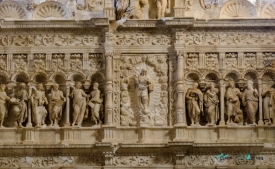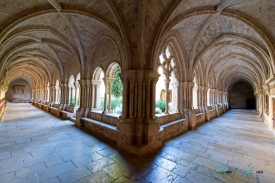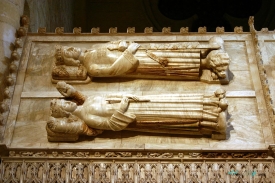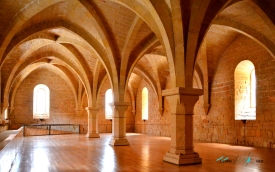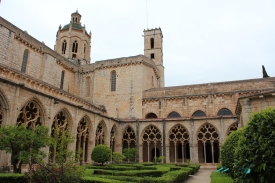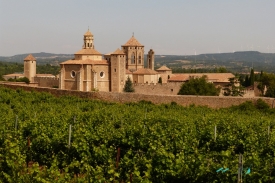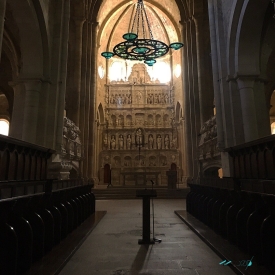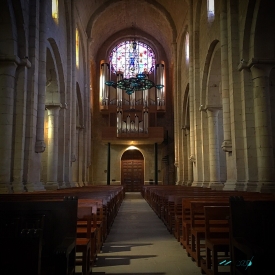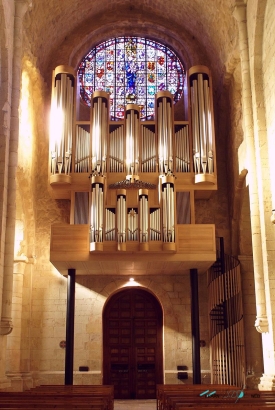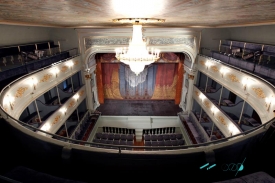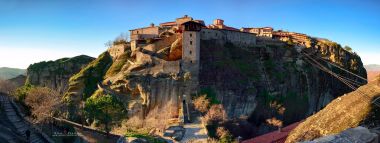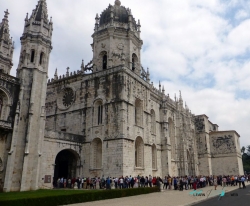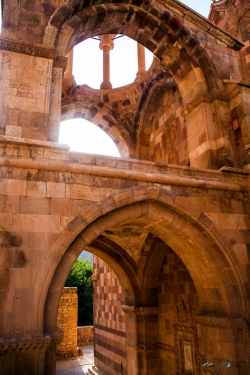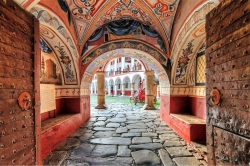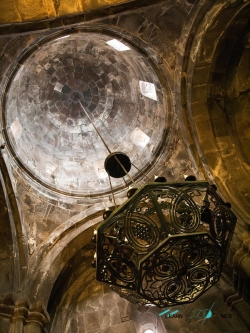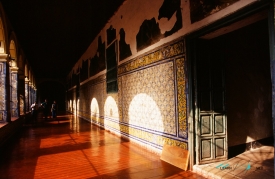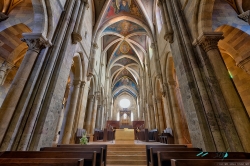ABOUT Poblet Abbey
The Royal Monastery of Santa María de Poblet, the largest monastic complex in Western Europe, was the burial place of the kings of the Crown of Aragon during the 13th and 14th centuries. It is one of the most important monasteries of the Roman Catholic Church and today it is inhabited and run by the same monastic order that founded it nine centuries ago. Its name derives from the Latin populetum for white poplar (Populus alba), a tree that grows abundantly along the rivers and streams of the area and whose white bark symbolizes the white customs of the Cistercian monks. The monastery, located 500 m a.s.l. in the foothills of the Serra de Prades, it is part of a Natural Site of National Interest created by the Generalitat de Catalunya in 1984 to protect the landscape around the monastery, declared a World Heritage Site by UNESCO in 1991.
At the height of its splendor, the monastery was home to more than 300 monks and had numerous "Cistercian farms" run by lay brothers who exploited its agricultural land and forests. The monastery buildings occupy about 12,000 m2. The World Heritage Site includes all the medieval buildings and the walled gardens and orchards that today are mainly dedicated to viticulture. In 2012 work began on a diagnosis of all the monastery gardens: within its walls there are more than 40 different gardens. The monastery also has a series of interior gardens, of which the most important are the medieval gardens of the main cloister, the cloister of San Esteban and the cloister of the Abbot.
The garden of the main cloister is the jewel of sacred art located stylistically in the transition between Romanesque and Gothic (13th-14th centuries) which historically has always been, and continues to be, the heart of this monastic complex.
The large cloister to the north of the church is the focal point. It dates mostly from the 13th century, although some parts may be older. The three-light windows on the north, east, and west sides have fine early pointed tracery, and the arches are carried on delicate shafts coupled with capitals. The windows on the south side have two round arches carried on shafts coupled with good capitals. The vaulting is quadripartite throughout. On the north side there is a six-sided chamber projection with a window of two round arches carried on coupled shafts on each side.
According to the Catalan historian Pablo Piferrer, there was a document in the library of Poblet, prior to the desecration in 1835, which gave an account of the donation of the lands of the abbey, made in 1120 by the Moorish king Almominiz to a hermit named Poblet, that he had been freed, three times from captivity, by the virgin and her angels. After the reconquest of Catalonia, by the Count of Barcelona, Ramon Berenguer IV, he founded the monastery in 1151, bringing thirteen monks of the Cistercian order, white friars, from the monastery of Fuenfria (Fontfroide, near Narbonne).
The great church, with its cloister, was built by Don Alfonso II, the chaste, being the first to be buried in the monastery. The next was Jacques I the Conqueror, who died in 1276. Until Don Juan II, father of Ferdinand the Catholic, almost all the kings, and many princes of Aragon, were buried in the abbey, which became what the Escorial became. to be under the Habsburgs, the richest and greatest religious monument of all the Spains of the Middle Ages, the last resting place of the noblest sons of Aragon.
The monastery reached its apogee in the 14th century. At that time, the property of the abbey extended from the Catalan Pyrenean foothills to the north of Valencia. In addition, the abbey library is especially well known, which still preserves the manuscript of the Chronicle of Jaime I the Conqueror, dating from the 14th century.
With the political changes of the 19th century in Spain, and the civil wars, the monastery began a period of decline. In 1822 their properties were put up for sale and the monks were expelled by the liberals who were at war with the absolutists. In 1825, during the ominous decade of Ferdinand VII, the monks returned and tried to restore order, restore the damage and recover some of what had been stolen. In 1833, during the First Carlist War, the monastery was looted, the tombs desecrated for gold and precious stones. Later many volumes and documents were recovered and the remains of the tombs were taken to Tarragona for safekeeping. Fearing the worst, the young and liberal friars, followed by the older ones, decided to seclude themselves and took refuge in private homes. They removed the most valuable and transportable belongings from the monastery, handing them over to private individuals; almost everything was lost.
At the height of its splendor, the monastery was home to more than 300 monks and had numerous "Cistercian farms" run by lay brothers who exploited its agricultural land and forests. The monastery buildings occupy about 12,000 m2. The World Heritage Site includes all the medieval buildings and the walled gardens and orchards that today are mainly dedicated to viticulture. In 2012 work began on a diagnosis of all the monastery gardens: within its walls there are more than 40 different gardens. The monastery also has a series of interior gardens, of which the most important are the medieval gardens of the main cloister, the cloister of San Esteban and the cloister of the Abbot.
The garden of the main cloister is the jewel of sacred art located stylistically in the transition between Romanesque and Gothic (13th-14th centuries) which historically has always been, and continues to be, the heart of this monastic complex.
The large cloister to the north of the church is the focal point. It dates mostly from the 13th century, although some parts may be older. The three-light windows on the north, east, and west sides have fine early pointed tracery, and the arches are carried on delicate shafts coupled with capitals. The windows on the south side have two round arches carried on shafts coupled with good capitals. The vaulting is quadripartite throughout. On the north side there is a six-sided chamber projection with a window of two round arches carried on coupled shafts on each side.
According to the Catalan historian Pablo Piferrer, there was a document in the library of Poblet, prior to the desecration in 1835, which gave an account of the donation of the lands of the abbey, made in 1120 by the Moorish king Almominiz to a hermit named Poblet, that he had been freed, three times from captivity, by the virgin and her angels. After the reconquest of Catalonia, by the Count of Barcelona, Ramon Berenguer IV, he founded the monastery in 1151, bringing thirteen monks of the Cistercian order, white friars, from the monastery of Fuenfria (Fontfroide, near Narbonne).
The great church, with its cloister, was built by Don Alfonso II, the chaste, being the first to be buried in the monastery. The next was Jacques I the Conqueror, who died in 1276. Until Don Juan II, father of Ferdinand the Catholic, almost all the kings, and many princes of Aragon, were buried in the abbey, which became what the Escorial became. to be under the Habsburgs, the richest and greatest religious monument of all the Spains of the Middle Ages, the last resting place of the noblest sons of Aragon.
The monastery reached its apogee in the 14th century. At that time, the property of the abbey extended from the Catalan Pyrenean foothills to the north of Valencia. In addition, the abbey library is especially well known, which still preserves the manuscript of the Chronicle of Jaime I the Conqueror, dating from the 14th century.
With the political changes of the 19th century in Spain, and the civil wars, the monastery began a period of decline. In 1822 their properties were put up for sale and the monks were expelled by the liberals who were at war with the absolutists. In 1825, during the ominous decade of Ferdinand VII, the monks returned and tried to restore order, restore the damage and recover some of what had been stolen. In 1833, during the First Carlist War, the monastery was looted, the tombs desecrated for gold and precious stones. Later many volumes and documents were recovered and the remains of the tombs were taken to Tarragona for safekeeping. Fearing the worst, the young and liberal friars, followed by the older ones, decided to seclude themselves and took refuge in private homes. They removed the most valuable and transportable belongings from the monastery, handing them over to private individuals; almost everything was lost.
The Best Pictures of Poblet Abbey
Videos of Poblet Abbey











